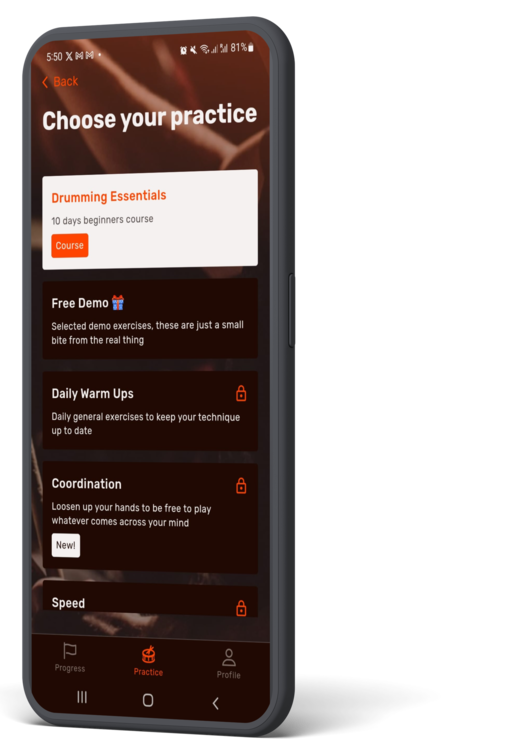Ready to elevate your drumming skills? Start your journey to greatness with Drum Coach! Dive into our Drumming Essentials course designed for beginners and enjoy:
🥁 5 minutes of fun, daily exercises.
🎵 A beginner-friendly approach to improve steadily.
💡 Engaging drum lessons that make learning easy and effective.
Embarking on the journey to master the drums is an exhilarating adventure, offering a unique blend of challenges and triumphs. Whether you’re tapping into the world of rhythm for the first time or refining your skills to reach professional heights, playing with confidence is key. This article outlines the roadmap to drumming success, from the foundational skills every beginner needs to the advanced techniques that distinguish the pros. Let’s dive into how you can build your confidence behind the kit at every stage of your drumming journey.
1. Fundamental Drumming Techniques for Beginners
The first step to playing with confidence is mastering the fundamental techniques. Proper grip and posture lay the groundwork for effective drumming, allowing for greater control and endurance.
Start with learning how to hold your drumsticks with the matched grip or traditional grip, and ensure your drum throne is adjusted so your thighs are parallel to the ground.
- Matched Grip: Both hands hold the sticks in the same manner, typically with the sticks lying between the thumb and index finger, supported by the middle finger. This grip is favored for its symmetry and ease of learning.
- Traditional Grip: Originating from military marching bands, the traditional grip has the left hand holding the stick differently from the right, with the stick resting between the thumb and index finger of the left hand, passing under the palm, and supported by the ring finger. This grip offers a different feel and balance, useful for certain styles of music like jazz.
Experimenting with both grips will allow you to find what’s most comfortable for you and suitable for the music you play.
Practice basic strokes (full, down, tap, and up strokes) to develop a dynamic playing style.
- Full Stroke: Starts and ends high, allowing for maximum stick height and volume.
- Down Stroke: Starts high but ends low, preparing the stick for softer notes.
- Tap Stroke: Both starts and ends low, producing softer, controlled sounds.
- Up Stroke: Starts low and ends high, setting the stick up for a louder note.
Practicing these strokes will improve your dynamic range and control over the volume and attack of each note.

Learning how to play drums includes learning the proper grip and posture, allowing you to get greater control and endurance.
Additionally, familiarize yourself with the essential drum rudiments, such as single and double strokes, paradiddles, and flams. Rudiments are patterns of stickings that form the foundation of drumming vocabulary. Key rudiments include:
- Single Stroke Roll: Alternating hits with each hand (R-L-R-L). This rudiment is fundamental for developing hand independence and evenness in strokes.
- Double Stroke Roll: Two hits per hand before switching (R-R-L-L). This rudiment helps in building hand speed and control.
- Paradiddle: A combination of single and double strokes (R-L-R-R, L-R-L-L). Paradiddles increase stick control and are essential for creating interesting and complex rhythmic patterns.
- Flam: A grace note followed by a primary note, creating a thicker sound (R-(grace note)L-main note, L-(grace note)R-main note). Flams add texture and accentuation to your playing.
- Drag: Similar to flams but with two grace notes, adding complexity and texture.
Mastering these rudiments and applying them in various combinations and tempos can dramatically enhance your drumming versatility and creativity.
Dedicating time to understanding and practicing these fundamental techniques—grip, strokes, and rudiments—is essential for any beginner. Not only do they form the basis for more advanced techniques and styles, but they also ensure that your drumming is expressive, controlled, and dynamic. By building a solid foundation in these areas, you’re setting the stage for a rewarding and confident drumming journey.
Get ready to take your drumming to the next level. Get expert tips on coordination, drumming techniques, improvisation and more in the post titled “Charting Your Drumming Journey”. / Written by: Raul Rodrigues: CEO of Drumap, Drummer, Music School Director and Mariano Steimberg: Drum Professor at Berklee College of Music, Valencia Campus.
2. Understanding Rhythm and Timing Essentials
Rhythm and timing are the heartbeats of drumming. Developing a solid sense of timing begins with understanding the basics of rhythm notation and how to count time signatures. Utilize a metronome during practice to internalize the pulse of the music, helping you stay on beat and improve your timing. Engage in exercises that challenge your rhythmic perception, such as playing along to different tempos or practicing with rhythm training apps. Mastering these elements will not only boost your confidence but also ensure your drumming is both tight and expressive.
Rhythm and timing are the heartbeats of drumming. Use a metronome during practice to internalize the pulse of the music.

Elevate Your Drumming Skills with Drumap Ready to transform how you write, share, and explore drum notes? Download Drumap, the Grammy Academy-awarded music app, and join a vibrant community of drummers and percussionists. With Drumap, you have access to:
💡 Built-in and adjustable metronome.
🎶 Over 150,000 drum samples and percussive rhythms.
📝 Tools to create and share your drum beats effortlessly.
3. Practice Routines That Yield Fast Improvement
Adopting effective practice routines is crucial for drummers aiming to advance their skills and master the drums. A well-structured practice routine targets different aspects of drumming, from fundamental techniques and rhythm accuracy to limb coordination and speed, ensuring a balanced development across all areas essential for proficient drumming. These routines often incorporate a variety of exercises designed to challenge and refine specific skills, making practice sessions both productive and engaging.
An element that can significantly enhance the effectiveness of these routines is the use of applications designed for drummers. Apps like DrumCoach, for instance, provide focused exercises on key performance aspects such as coordination and speed, enabling drummers to pinpoint and work on their weaknesses systematically. By integrating such technology into practice routines, drummers can access personalized guidance and feedback, facilitating targeted improvements and more efficient skill development. This tailored approach ensures that every practice session contributes directly to becoming a more confident and capable drummer.
Find your perfect practice routine with Drum Coach with drumming exercises tailored for all levels. With Drum Coach you get:
- Drums lessons crafted by Mariano Steimberg, professional drummer, and professor at Berklee College of Music.
- Unlock over 500 drum exercises and rudiments
- Start Free with the Drumming Essentials course. No fancy gear needed!

Structured and consistent practice is crucial for rapid improvement on the drums. Create a balanced practice routine that includes warm-up exercises, technique drills, rudiment practice, and playing along to music. Incorporate slow, deliberate practice to focus on accuracy, then gradually increase speed while maintaining control. Set specific, achievable goals for each practice session to keep motivated and track your progress. Remember, quality trumps quantity; focused, intentional practice for shorter periods is often more effective than long, unfocused sessions.
4. How to Play Along with Your Favorite Songs
Playing along with your favorite songs is not only immensely enjoyable but also a powerful tool for developing your drumming skills. It teaches you how to listen critically, adapt your playing to different musical styles, and improvise. Start by choosing songs with simple drum parts and work your way up to more complex tracks as your confidence grows. Use software that allows you to slow down the music without altering the pitch, making it easier to catch every nuance of the drum parts. This practice will sharpen your ability to play in sync with other musicians and prepare you for live performances.
Take advantage of our curated playlists, prepared for beginners to advanced drummers. Play your favorites songs with drum notes in our Drumap App and adjustable metronome:
- Top 10 Easy drum Songs for Beginners
- How to Play the Hardest Drum Songs
- The Best Drum Songs in Music History
Ready to elevate your drumming? Drumap offers over 150,000 drum samples and rhythms, making creating and sharing your beats a breeze. Dive into the world of rhythm with expert tips!
5. Navigating the Drummer’s Journey from Beginner to Advanced
Transitioning from a beginner to an advanced drummer is a journey of continuous learning and growth. As you become comfortable with the basics, challenge yourself with more advanced techniques like odd time signatures, dynamic control, and speed and endurance exercises. Explore different genres to broaden your musical vocabulary and versatility. Seek feedback from other drummers and instructors, and consider joining bands or ensembles to gain experience playing in diverse settings. Above all, embrace the journey, celebrating your achievements and learning from setbacks with equal enthusiasm.
Confidence in drumming comes from a deep understanding of rhythm, mastery of fundamental techniques, and the relentless pursuit of improvement. By following these guidelines, drummers can navigate their musical journey with assurance and joy, ready to face the challenges and opportunities that lie ahead. Remember, confidence is not just about playing without mistakes; it’s about expressing yourself through the drums with conviction, passion, and resilience, from beginner to pro.
Dreaming of becoming a drumming pro? Dive into Drum Coach’s world, where every beginner finds their groove! With the Drumming Essentials course you get:
🥁 Fun 5-minute daily routines.
🎵 Progress at your pace, perfect for starters.
💡 Engaging lessons that make learning easy and effective.
Check out our Drum Set Guide for beginners. Get tips and an estimated budget on How to find your perfect drum kit. You may also find interesting our top recommended rudiments on our post Rudiments to Rhythms: Drum Rudiments for Versatile Playing










